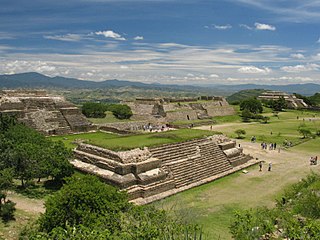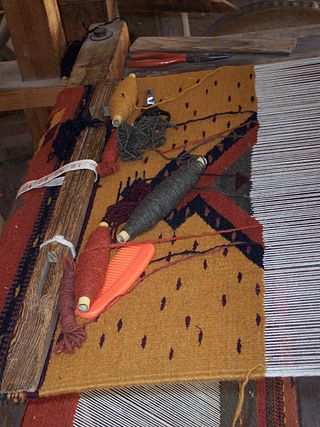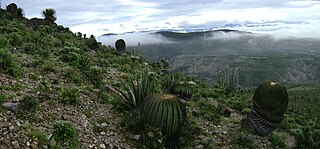
Mezcal, sometimes spelled mescal, is a distilled alcoholic beverage made from any type of agave.

Oaxaca, officially the Free and Sovereign State of Oaxaca, is one of the 32 states that compose the Federative Entities of Mexico. It is divided into 570 municipalities, of which 418 are governed by the system of usos y costumbres with recognized local forms of self-governance. Its capital city is Oaxaca de Juárez.

Oaxaca de Juárez, or simply Oaxaca, is the capital and largest city of the eponymous Mexican state of Oaxaca. It is the municipal seat for the surrounding municipality of Oaxaca. It is in the Centro District in the Central Valleys region of the state, in the foothills of the Sierra Madre at the base of the Cerro del Fortín, extending to the banks of the Atoyac River.

The Sierra Madre del Sur is a mountain range in southern Mexico, extending 1,000 kilometres (620 mi) from southern Michoacán east through Guerrero, to the Isthmus of Tehuantepec in eastern Oaxaca.

Tigridia, is a genus of bulbous or cormous flowering plants belonging to the family Iridaceae. With common names including peacock flowers, tiger-flowers or shell flowers, they have large showy flowers; and one species, Tigridia pavonia, is often cultivated for this. The approximately 60 species in this family grow in the Americas, from Mexico down to Chile.

Alfredo Harp Helú is a Mexican businessman of Lebanese origin, and as of 2011, with a net worth of $1.5 billion, is according to Forbes the 974th richest person in the world. He is also the cousin of multibillionaire Carlos Slim.

Uxpanapa is a municipality in the southeastern part of the Mexican state of Veracruz, adjacent to the state of Oaxaca. It is bordered by the municipalities of Jesús Carranza, Hidalgotitlán, Minatitlán, and Las Choapas in Veracruz, as well as Santa María Chimalapa in Oaxaca. It has an area of 2,600 km².

Ulises Ernesto Ruiz Ortiz is a Mexican politician and former governor of the State of Oaxaca. He took office in 2004 as a member of the Institutional Revolutionary Party (PRI).

Acritodon is a genus of moss in the family Hypnaceae. It is a monotypic genus only containing the species Acritodon nephophilusAcritodon nephophilus is endemic to Mexico, where it is known only from two locations in the Sierra Madre de Oaxaca of Oaxaca state. Its natural habitat is subtropical or tropical moist lowland forests. It is threatened by habitat loss. Conservation efforts for this species have difficulty protecting local populations due to insufficient attention and legislation regarding preservation of moss species.

Quercus martinezii is a species of oak found in southwestern and central Mexico. It has been found in Nayarit, Jalisco, Michoacán, Guerrero, and Oaxaca states. It is placed in Quercus section Quercus.

The state of Oaxaca in southern Mexico has a noteworthy tradition of finely crafted textiles, particularly handmade embroidery and woven goods that frequently use a backstrap loom. Oaxaca is home to several different groups of indigenous peoples, each of which has a distinctive textile tradition.

The Corporación Oaxaqueña de Radio y Televisión is a government agency of the Mexican state of Oaxaca charged with the operation of radio and television stations in the state.
Elotepec Zapotec is a Zapotec language of a single village in western Oaxaca, Mexico, San Juan Elotepec in the Municipio of Villa Sola de Vega. It is one of several Zapotec languages called Papabuco, and has 68% intelligibility of Zaniza Zapotec.

Cassiano Conzatti, aka Cassiano Bartolameotti-Conzatti, was a botanist, botanical explorer and pteridologist, and director of the Oaxaca Botanical Garden in Mexico. Conzatti lived and worked in Mexico for the greater part of his life and was an early authority on the flora of Oaxaca.

Oaxaca handcrafts and folk art is one of Mexico's important regional traditions of its kind, distinguished by both its overall quality and variety. Producing goods for trade has been an important economic activity in the state, especially in the Central Valleys region since the pre-Hispanic era which the area laid on the trade route between central Mexico and Central America. In the colonial period, the Spanish introduced new raw materials, new techniques and products but the rise of industrially produced products lowered the demand for most handcrafts by the early 20th century. The introduction of highways in the middle part of the century brought tourism to the region and with it a new market for traditional handcrafts. Today, the state boasts the largest number of working artisans in Mexico, producing a wide range of products that continue to grow and evolve to meet changing tastes in the market.

Quercus glabrescens is a species of oak. It is endemic to the mountains of east-central Mexico.

Quercus castanea is a species of oak tree. It is widespread across much of Mexico, from Sonora to Chiapas, and in Guatemala, El Salvador, and Honduras.

The Tehuacán-Cuicatlán biosphere reserve is a protected natural area located in southeastern Mexico. Its name derives from its two main locations: Cuicatlán and Tehuacán, in the latter are their administrative offices, covers 490,186 hectares distributed among 21 municipalities in the state of Puebla and Oaxaca.

Lobelia polyphylla, called the tabaco del Diablo, is a species of flowering plant in the family Campanulaceae, native to northern and central Chile. When smoked, it has narcotic and hallucinogenic effects.

Cañón del Río Blanco National Park is protected natural area in Mexico's Veracruz state.


















